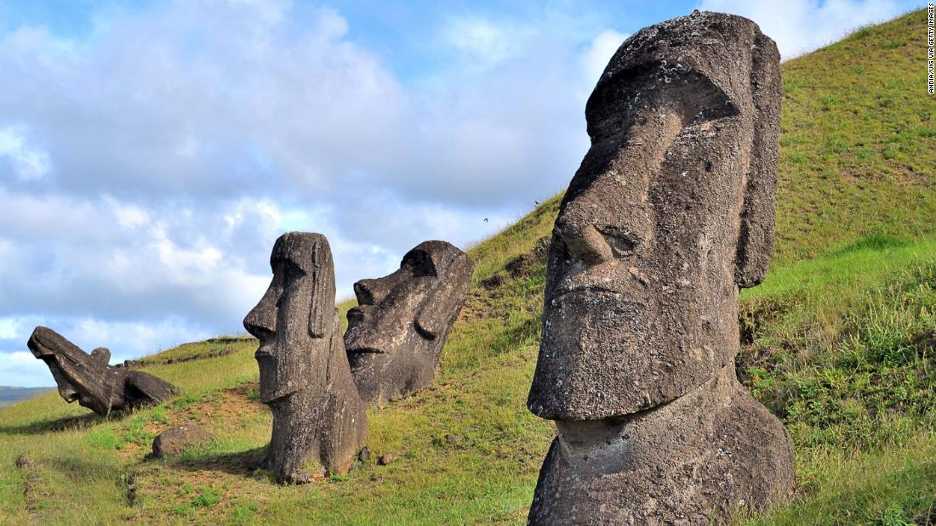New DNA Evidence Pokes Holes in Easter Island Ecocide Theory
- Triple Helix
- Oct 28, 2024
- 4 min read

Picture credit: Andia/UIG via Getty Images
Written by Ava Steger ‘27
Edited by Helen Chow ‘26
The story of Rapa Nui has been shrouded with mystery for centuries, telling a tale of cannibalism, societal collapse, and harrowing environmental destruction. Yet, today’s scientific advancements have begun shining light on these murky theories.
In 700 A.D, a group of Polenesian settlers sailed to the island of Rapa Nui[1]. This civilization grew to an unsustainable level, with unlimited access to nutrient rich soil, thick forests, and teeming oceans. Nature could not keep up with their demand, and soon nothing was left. The islanders were forced into war, cannibalism, and a genetic bottleneck. This is what the European settlers found when they touched down on Rapa Nui in the 1700s and renamed it Easter Island. Or that's how the story has been told.
This oversimplified history raised red flags for many researchers as history is rarely this simple. The first oversight was raised in 2016 by a group of anthropologists who determined that obsidian flakes found peppered around the island were not evidence of “mass warfare,” but most likely had been used for rituals or domestic tasks[2]. Further investigation in 2020 mapped the construction of ahu, or the ritual stone heads Rapa Nui is known for. Archeologists took samples from the ahu statues and were able to roughly date their creation using radiocarbon dating[3]. This process compares two isotopes of carbon: one that is stable, 12C, and one that is radioactive, 14C. The amount of 12C in a sample will stay constant for thousands of years. However, radioactive isotopes decay, and for 14C, its mass is halved every 5,700 years. When an organism is alive, the amount of 14C is equal to the amount of 12C. So, scientists can compare the ratio of the two isotopes to determine how many years have passed up to 55,000 years, in which the 14C would have completely decayed. The researchers in this study dated the charcoal mixed into the stone of many ahu and determined that the latest ahu was built 300 years ago. Instead of halting construction at the time of the proposed population decline, this study showed that the ahu had been built at a steady rate until coming in contact with Europeans in the 1700s, indicating a healthy, resilient community.
New genetic testing has allowed scientists to place even more pieces into the ever-changing puzzle of Rapa Nui. As the field of genetics has evolved, one of its more unique and useful applications has been sequencing the genomes of ancient people to understand their history better. Researcher J. Víctor Moreno-Mayar used this strategy to create a genetic history of Rapa Nui. His team gathered DNA from 15 ancient Rapa Nui skeletons from the Muséum national d’Histoire naturelle in France to determine if there had been a genetic bottleneck. A genetic bottleneck happens when a population declines, and there is a resulting decrease in the gene pool - or the number of unique genetic and physical traits available to a population[1]. However, they first had to radiocarbon date the skeletons to ensure the DNA was purely from the Rapa Nui lineage and had not been mixed with any other genes. The radiocarbon data confirmed that the skeletons were from 400 years prior, which was before any outsiders stepped foot on Rapa Nui. With the confirmation that the DNA was only from Rapa Nui lineage, Moreno-Mayar acquired the genetic sequences from each of the skeletons. The genetic sequences gathered were used in reconstructing the possible gene pool available during the time of the proposed societal collapse. The researchers then coded multiple simulations of what genetic sequences would have looked like if there had been a genetic bottleneck. These computer generated simulations were compared to the observed sequencing data of the 15 Rapa Nui skeletons, but the simulations did not match the observed data[1]. Therefore, there is no proof of a genetic bottleneck or population ecocide in the 1600s before European contact.
While this does not shed light on exactly what happened to the population of Rapa Nui, it does provide space for different conclusions, and excitement for what genetic testing can uncover in the future. It is likely that the cause of the population decline in Rapa Nui was impacted by the colonization of the island by Europeans. As with the colonization of America, it has been documented that John Cook and other European settlers brought with them smallpox, which devastated the Native Rapa Nui population in the 1860s and marked the beginning of the Peruvian slave raids - further decreasing the population to just over 100 people in 1877[3]. Although the Native population on Rapa Nui is now thriving at 7,800 people, this mistaken history continues to impact communities and classrooms[1]. Much of history was written by white Europeans in power, who many times held racist and classist views that tinge history books. It is therefore increasingly important to question who these theories arise from and what evidence supports these claims. As the field of genetic testing advances, there will be many more opportunities to dig into scientific theories and provide insight into what the world used to look like.
References
Moreno-Mayar JV, Sousa Da Mota B, Higham T, Klemm S, Gorman Edmunds M, Stenderup J, et al. Ancient Rapanui genomes reveal resilience and pre-European contact with the Americas. Nature. 2024 Sep 12;633(8029):389–97.
Lipo CP, Hunt TL, Horneman R, Bonhomme V. Weapons of war? Rapa Nui mata’a morphometric analyses. Antiquity. 2016 Feb;90(349):172–87.
DiNapoli RJ, Rieth TM, Lipo CP, Hunt TL. A model-based approach to the tempo of “collapse”: The case of Rapa Nui (Easter Island). Journal of Archaeological Science. 2020 Apr;116:105094.




Comments